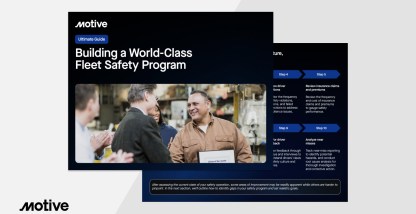Earlier this year, a tragic truck collision in Denver ended up in the deaths of four innocent people and sparked a deeper conversation about fleet safety in the trucking industry. Was the crash caused by the brakes burning out? Could it have been avoided with better driver coaching?
Chad Boblett, owner of Boblett Brothers, LLC and Rate Per Mile Master, is an expert when it comes to trucking and fleet safety. He has been down the Denver I-70 many times and knows how to handle a truck and trailer down this steep mountain grade. “This is a steep grade mountain coming down into Denver on I-70. The brakes likely failed on the truck because they got too hot. [There are a lot of] hard corners going down this mountain and if drivers are going too fast they may lose control,” Boblett said.
Chad says the driver, who was new to the industry, was most likely unfamiliar with how to navigate the tricky, mountainous roads of Colorado. In addition, Chad notes the driver’s truck was “fully loaded” and the driver may have been going too fast.
In instances like these, fleet and safety managers that use Motive’s fleet management system would be alerted when aggressive driving events (hard cornering and braking) are triggered. Using this data can help safety managers coach drivers so they can better handle difficult terrain like steep mountains and hairpin turns.
Why are truck collisions increasing?
The U.S. Department of Transportation shows since 2008 there has been a steady increase in the number of fatal truck collisions in the U.S. (page 18). As the economy grows, so does the demand for supply. With the increasing demand for truck deliveries and more traffic, drivers and companies face the challenge of avoiding collisions.
Fleet safety is a shared goal. It is not only shared between the driver and the company, but with everyone else on the road.
Read: Anti-lock brakes, fleet vehicles, and safety.
New rules coming soon
In 2020, the Federal Motor Carriers Association (FMCSA) will introduce Entry-Level Driver Training (ELDT) to enhance current driver training and increase fleet safety on the roads. (Note: The FMCSA may delay implementation until 2022. You can get the details on FederalRegister.gov.)
This newly legislated training is designed to decrease the number of truck-related collisions by increasing and standardizing the training new drivers receive. The big question about this new training is: “Is it enough?”
Need for increased training for new drivers
Veteran truck drivers like Boblett understand how to react to various driving situations. Boblett states that rookie drivers, who have improper training, often panic, overreact, or make wrong decisions. He shares some of his best tips for driving safely:
- Be aware of your downhill speed. If you’re at full capacity, know that the weight is going to be pushing you downhill. You can’t just suddenly use your brakes and expect to slow down without burning them out.
- Always pay attention to the speed limit. Go 5 mph slower than the posted limit. You will never be going too fast by doing this.
- Know what gear you need to be in before going downhill. If you are going too fast, it is often too late to downshift.
- Watch for steep grade signs along the highways as well as speed limits.
Chad posted a poll on his Facebook group, Rate Per Mile Masters, asking his followers (mostly owner-operators) about the best ways to prevent collisions when cornering or going downhill.
Here are the results of the poll:
- 16 percent: Use lower gears and “jake brake” to avoid burning out your brakes
- 5 percent: Use runway truck ramp if you can’t slow the truck down
- 4 percent: Go slower than the posted truck speed limit
- 1 percent: Double, or in some cases, triple your following distance
- 74 percent: All of the above
The onus for safety does not lie solely with the truck driver. Fleet owners and safety managers all play a key role, and all must work together as a team to address concerns about safety.
Data from ELDs must be monitored and analyzed. This data can then be used as a training tool to aid the driver in becoming safer on the road.
This data can also be used as an incentive for drivers to continue to improve their driving records and aid others who need improvement.
Overview of roads with known hard braking/cornering
Chad discusses driving issues truKkers face on some U.S. highways where hard braking and cornering triggers a warning on the ELD. Motive reviewed anonymized data aggregated from ELDs to determine routes with high instances of hard braking, cornering, and acceleration.
- US 278 GA/6 West of Atlanta — This route is heavily traveled, has some downgrades, and sharp turns. If a driver is not paying attention, it may be easy to lose control.
- I-5 between Medford, OR and Roseburg, OR — This stretch of highway is a steady descent with sharp curves. The posted speed limit on most sections is 45 mph for trucks, which may be too fast. Watch the speed when carrying a heavy load.
- I-15 between Las Vegas, NV and Salt Lake City, NV — The posted speed limit is 70 mph, which may be too fast. This road could be tricky, since there is a long stretch of road, before sharp turns.
Boblett says the key to fleet safety is to pay attention and be proactive when driving. The majority of truck collisions are not the fault of the truck driver.
Increase fleet safety
A well-rounded and comprehensive fleet safety program can help with driver training, changing unsafe driving habits, and improving driver retention. Learn more about the Motive fleet safety solution.









